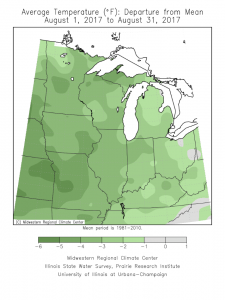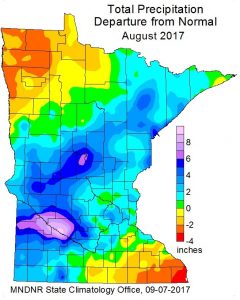Cooler August Than Usual
Sep 12, 2017
Brrr! Did August seem cooler than usual to you? Farmers around the Twin Cities would probably agree with you. Below-average temperatures last month caused plants like tomatoes and peppers not to ripen and change colors. August was the 24th coolest August on record since 1895. 2009 was the last time August was the 24th coolest on record. The National Weather Service climate report for the Twin Cities also reported an average temperature of 68.°F, which is 2.5°F below normal. The image below the chart, from the Midwest Regional Climate Center (via the MN DNR) shows the average temperature departure from the mean. The mean data was collected between 1981 and 2010. Minnesota is anywhere from 1 to 5 degrees cooler on average than the mean temperature.
Last month, was also the 11th wettest August across the state, dating back to 1895 (MN DNR, 2017). The statewide precipitation total was 1.71 inches above average (MN DNR, 2017). The average precipitation reported for August by the NWS Twin Cities was 6.75 inches, 2.45 inches above normal (NWS, 2017). The Total Precipitation Departure from Normal image from the MN DNR, shows that Hennepin County precipitation was up to four inches above normal. Below are the average temperatures and total rainfall seen at the mesonet stations across Hennepin County:
| Mesonet Station | Average Monthly Temperature (°F) | Monthly Total Precipitation (inches) |
|---|---|---|
| St. Bonifacius | 66.05 | 2.70 |
| Minnetrista | 65.72 | 6.41 |
| Medina | 69.57 | 1.51 |
| MSP Airport | 66.81 | 1.01 |
| Orono | 67.10 | 9.01 |
| Greenfield | 66.07 | 1.09 |
| Rockford | 66.11 | 6.00 |
| Hanover | 66.72 | 3.90 |
| Maple Grove | 67.14 | 1.72 |


References:
MN Department of Natural Resources. HydroClim Minnesota for Early September 2017. September 7, 2017. State Climatology Office – DNR Division of Ecological and Water Resources, St. Paul. http://www.dnr.state.mn.us/hydroclim/hc1709.html
National Weather Service. August 2017 Climate Summary. September 1, 2017. http://w2.weather.gov/climate/index.php?wfo=dlh